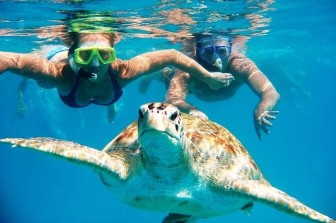Diving Sites in Port Blair




inHavelock)
inHavelock)
inHavelock)
Activity Summary:
- Underwater scuba dive for 45 min
- Participant scuba dive Certificate
- Personal instructor.
- Instructor and participant ratio is 1:1
- Complementary photography and videography.
- Participants should be 12 yrs and above and physically and mentally fit enough to dive.
- Swimming not required.
- Dive site – Red Pillar/Tribe Gate , Depth – 12 meters
- Total Duration Of the Activity - 3 Hours
- Free pickup drop up to 3 km from Havelock Island Beach Resort.
If you’re standing at Havelock Island and the waves are calm, you’d never guess the kind of world that exists just a few meters offshore. At Turtle Beach, beneath the sea surface, there's a completely different and new world. A world without roads, noise, or screens. Here, you don’t walk; you float, you don’t speak; you breathe. The PADI Discover Scuba Diving (DSD) program at Turtle Beach isn’t just for people with diving licenses. It’s for anyone, especially those who’ve never tried it before, maybe never even thought they would. It’s the kind of beginning that sticks with people. Not because it’s loud or exciting. But it slows everything down.
You don’t rush through it. You just stay there. This dive isn’t really about looking at things. It’s more about being part of them for a while. The reef is close enough to the surface for the light to get in. And that changes what you see. The sun doesn’t just light up the water. It cuts through it in strips. Everything under there looks different when the light moves.Shoals of fish reflect light like underwater mirrors. The coral moves—not from currents but from the tiny lives pulsing within it. And through all of this, you breathe slowly. You don’t need to swim. You don’t need to panic.
There’s a professional diver by your side the entire time. One-on-one. Watching every breath, every movement, guiding your hands when they float too far, tapping gently on your arm if you drift.
This isn’t the kind of beach where tourists crowd in for selfies. Turtle Beach is quiet. Most people who come here for the DSD program barely even speak on the boat ride back. Not because they’re tired, but because something internal has shifted. You don’t just see fish. You watch how they navigate territory. How do they stay close to rock or coral? How they retreat and return. You watch life in a way that’s not possible from land. Not through glass. Only from underwater.
Why Turtle Beach Is Ideal for a First Dive
Turtle Beach isn’t randomly chosen for the Discover Scuba Diving activity. There’s a reason instructors bring beginners here. The underwater slope is gentle. The visibility is usually excellent. You don’t encounter strong, unpredictable currents here. For someone entering the ocean for the first time, that’s more important than they might realize.
The coral at Turtle Beach isn’t messed up. It’s not like those places where everything looks broken or crowded. Here, it’s still clean. Still looks like it’s supposed to. You’ll see coral that’s flat and wide like tables, some shaped like brains, and those soft, fan-like ones that move with the water. Nothing feels forced. It all just fits together. The fish move through like they’ve done it forever. And sometimes, if the water’s not too high and the light hits right, you might see a turtle way off near the deeper side. Not always, but sometimes.
It’s not just marine life that makes this dive unique. It’s the atmosphere. This beach doesn’t overwhelm you. It doesn’t have music blaring or water scooters tearing up the surface. The focus is quiet. Controlled. Personal.
What Happens During the Dive
The process begins well before you’re in the water. Once you arrive—either via the included pickup if you're staying within 3 km of Havelock Island Beach Resort or on your own—you’ll meet the dive team. These aren’t just instructors; they’re trained to deal with first-timers, to read fear, to respond to silence. They’ll explain the gear: the regulator, the tank, the buoyancy control device (BCD). They’ll fit you with a wetsuit and mask. Everything is customized to your size. You're not just handed gear and sent into the sea.
Before anything begins, there’s a bit of time spent in shallow water.
About fifteen minutes or so. You’ll be shown how to breathe through the regulator. How to clear your mask if it fogs or takes in water. The instructor shows you the signs. What to do if you want to come up. What does it mean if you’re not okay? No rush. If you’re nervous, you get more time. The instructor doesn’t move on until you’re ready.
Then the dive starts. It lasts around forty-five minutes. You go down slowly, with the instructor right there. You’re not pushed. Twelve meters is the limit, and even that’s only if you’re okay with it. The sea here doesn’t throw surprises. The surface calms down once you’re under. Things begin to look different. Reds fade first. Then orange. Everything becomes shades of blue and green. You spot small things at first. A clownfish slipping back into its anemone. A parrotfish is chewing on coral. Feather stars are opening and closing like they’re breathing. Sometimes, if the sand is still, you might see a stingray half-buried and watching. You don’t talk. You can’t. Everything is said with a look or a hand signal. And the instructor stays with you. They control your movement if needed. They check if you’re floating too much or sinking too fast. You’re never left to figure it out alone. That’s what makes it work.
What’s Included in the Boat Diving At Turtle Beach in Havelock Island
This isn’t a hurried, commercial experience. Every part of the DSD at Turtle Beach has been designed to keep things personal and professional. You’ll receive:
- You stay underwater for around 45 minutes. That’s your actual dive time. Not counting training or travel. Just you, breathing slowly, moving through the reef. No rush. No distraction. You’re not watching the clock or being pushed out early.
- You’re given a certificate after the dive. It’s not a diving license, but it’s proof you went in, did it, came out. Your name’s on it. So is the date. The instructor signs it. A simple memory to hold.
- There’s one instructor just for you. Not shared. Not rotating. The instructor is assigned only to you the entire time. From briefing to the last breath underwater. It’s a 1:1 setup—personal, steady, no mixed instructions.
- The dive instructor stays right next to you. One-on-one means no guessing, no following a line of people. They guide you directly, watch your signals, and adjust the pace to match your comfort.
- Photos and videos are part of the experience. They take care of it while you’re diving. No need to carry or rent anything. You don’t even have to ask. It’s done for you. All included. You just focus on diving.
- You must be at least 12 years old to join. It’s not just about age—being mentally alert and physically okay matters too. Nobody is rushed into the water. If you’re not feeling well, they won’t take you in. It’s safety-first.
- You don’t need to swim. That’s not a requirement. Breathing through the regulator, learning the signals, staying calm—those are what matter. The instructor handles the rest. You’re guided through everything.
- The dive happens at Red Pillar or Tribe Gate. Both sites go to a depth of 12 meters. Which one you go to depends on the day, water clarity, current, and weather. You don’t have to pick. They know what works best that morning.
- The whole activity takes about 3 hours. That includes your briefing, training, the dive itself, and the ride to and from the site. It’s not a quick dip. You’re given time to learn and ease into it.
- They’ll pick you up if you’re staying nearby. If your place is within 3 km of Havelock Island Beach Resort, they arrange pickup and drop-off. No confusion or extra planning. You don’t have to figure anything out.
Important Things to Know Before You Book
The best conditions usually fall between October and May. Outside of that, during monsoon, the sea can get unpredictable. Visibility drops, safety takes a hit, and it’s never wise to plan blindly. If you use glasses, speak up in advance. Prescription masks exist, but they’re few. You don’t want to be at the dive center and find out they’ve all been taken. Wearing contact lenses is usually fine underwater, though it’s still something to talk through with your instructor before heading in.
There’s something else you can’t ignore—your flight. Never book a dive too close to it. You need at least 12 to 18 hours after diving before flying. That gap isn’t a formality. It’s because nitrogen builds up in your body when you dive. Flying too soon can trigger decompression sickness, which isn’t worth the risk. If your schedule is tight, move things around. And skip the alcohol the night before. Even a small amount can mess with how your body handles pressure. Arrive rested. Eat light. Stay away from oily or heavy food right before diving. But above all, pay attention. What your instructor says isn’t filler—it’s what keeps you safe in an environment your body isn’t built for.
X
Enquire Now
X
Book Now
Diving Sites in Port Blair
Diving Sites in Havelock Island
Diving Sites in Neil Island